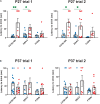Baseline Depression-Like Behaviors in Wild-Type Adolescent Mice Are Strain and Age but Not Sex Dependent
- PMID: 34690714
- PMCID: PMC8529326
- DOI: 10.3389/fnbeh.2021.759574
Baseline Depression-Like Behaviors in Wild-Type Adolescent Mice Are Strain and Age but Not Sex Dependent
Abstract
Depression is a major neuropsychiatric disorder, decreasing the ability of hundreds of millions of individuals worldwide to function in social, academic, and employment settings. Beyond the alarming public health problem, depression leads to morbidity across the entire age including adolescence and adulthood. Modeling depression in rodents has been used to understand the pathophysiological mechanisms behind this disorder and create new therapeutics. Although women are two times more likely to be diagnosed with depression compared to men, behavioral experiments on rodent models of depression are mainly performed in males based on the assumption that the estrous cycles in females may affect the behavioral outcome and cause an increase in the intrinsic variability compared to males. Still, the inclusion of female rodents in the behavioral analysis is mandatory to establish the origin of sex bias in depression. Here, we investigated the baseline depression-like behaviors in male and female mice of three adolescent wild-type inbred strains, C57BL/6N, DBA/2, and FVB/N, that are typically used as background strains for mouse models of neuropsychiatric disorders. Our experiments, performed at two different developmental stages during adolescence (P22-P26 and P32-P36), revealed strain but no sex differences in a set of depression-related tests, including tail suspension, sucrose preference and forced swim tests. Additionally, the 10-day interval during this sensitive period uncovered a strong impact on the behavioral outcome of C57BL/6N and FVB/N mice, highlighting a significant effect of maturation on behavioral patterns. Since anxiety-related behavioral tests are often performed together with depression tests in mouse models of neuropsychiatric disorders, we extended our study and included hyponeophagia as an anxiety test. Consistent with a previous study revealing sex differences in other anxiety tests in adolescent mice, male and females mice behaved differently in the hyponeophagia test at P27. Our study gives insight into the behavioral experiments assessing depression and stresses the importance of considering strain, age and sex when evaluating neuropsychiatric-like traits in rodent models.
Keywords: depression; forced swim test; hyponeophagia test; sex differences; sucrose preference test; tail suspension test.
Copyright © 2021 Eltokhi, Kurpiers and Pitzer.
Conflict of interest statement
The authors declare that the research was conducted in the absence of any commercial or financial relationships that could be construed as a potential conflict of interest.
Figures




Similar articles
-
Sex Differences in Depression-Like Behaviors in Adult Mice Depend on Endophenotype and Strain.Front Behav Neurosci. 2022 Mar 17;16:838122. doi: 10.3389/fnbeh.2022.838122. eCollection 2022. Front Behav Neurosci. 2022. PMID: 35368297 Free PMC article.
-
Behavioral tests assessing neuropsychiatric phenotypes in adolescent mice reveal strain- and sex-specific effects.Sci Rep. 2020 Jul 9;10(1):11263. doi: 10.1038/s41598-020-67758-0. Sci Rep. 2020. PMID: 32647155 Free PMC article.
-
Comprehensive characterization of motor and coordination functions in three adolescent wild-type mouse strains.Sci Rep. 2021 Mar 22;11(1):6497. doi: 10.1038/s41598-021-85858-3. Sci Rep. 2021. PMID: 33753800 Free PMC article.
-
Evaluating social defeat as a model for psychopathology in adult female rodents.J Neurosci Res. 2017 Jan 2;95(1-2):763-776. doi: 10.1002/jnr.23971. J Neurosci Res. 2017. PMID: 27870445 Review.
-
The tail suspension test as a model for assessing antidepressant activity: review of pharmacological and genetic studies in mice.Neurosci Biobehav Rev. 2005;29(4-5):571-625. doi: 10.1016/j.neubiorev.2005.03.009. Neurosci Biobehav Rev. 2005. PMID: 15890404 Review.
Cited by
-
Development of behavioral patterns in young C57BL/6J mice: a home cage-based study.Sci Rep. 2022 Feb 15;12(1):2550. doi: 10.1038/s41598-022-06395-1. Sci Rep. 2022. PMID: 35169182 Free PMC article.
-
Phenotyping Young GluA1 Deficient Mice - A Behavioral Characterization in a Genetic Loss-of-Function Model.Front Behav Neurosci. 2022 Jun 2;16:877094. doi: 10.3389/fnbeh.2022.877094. eCollection 2022. Front Behav Neurosci. 2022. PMID: 35722188 Free PMC article.
-
Sex-dependent astrocyte reactivity: Unveiling chronic stress-induced morphological changes across multiple brain regions.Neurobiol Dis. 2024 Oct 1;200:106610. doi: 10.1016/j.nbd.2024.106610. Epub 2024 Jul 18. Neurobiol Dis. 2024. PMID: 39032799 Free PMC article.
-
Maternal immune activation with toll-like receptor 7 agonist during mid-gestation alters juvenile and adult developmental milestones and behavior.J Neuroendocrinol. 2024 Aug;36(8):e13417. doi: 10.1111/jne.13417. Epub 2024 Jun 1. J Neuroendocrinol. 2024. PMID: 38822791 Free PMC article.
-
Spared nerve injury decreases motivation in long-access homecage-based operant tasks in mice.Pain. 2024 Jun 1;165(6):1247-1265. doi: 10.1097/j.pain.0000000000003123. Epub 2023 Nov 27. Pain. 2024. PMID: 38015628 Free PMC article.
References
-
- American-Psychiatric-Association [APA] (2013). Diagnostic and Statistical Manual of Mental Disorders, Fifth Edition (DSM-5TM). Arlington, VA: American Psychiatric Association.
-
- Andrade L., Caraveo-Anduaga J. J., Berglund P., Bijl R. V., De Graaf R., Vollebergh W. (2003). The epidemiology of major depressive episodes: results from the International Consortium of Psychiatric Epidemiology (ICPE) Surveys. Int. J. Methods Psychiatr. Res. 12 3–21. 10.1002/mpr.138 - DOI - PMC - PubMed
LinkOut - more resources
Full Text Sources
Molecular Biology Databases
Research Materials

